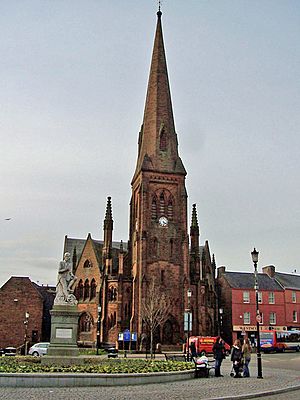Christopher Seton facts for kids
Quick facts for kids
Sir Christopher Seton
|
|
|---|---|
| Born | 1278 England |
| Died | 1306 Dumfries, Scotland |
| Spouse(s) | Christina Bruce |
| Parents | John de Seton Erminia Lascelles |
Sir Christopher Seton (born 1278, died 1306) was an important noble from the 13th century. He owned land in both England and Scotland. Sir Christopher was a strong supporter of Robert the Bruce, who later became King of Scots. He even married Robert the Bruce's sister, Christina Bruce.
Christopher Seton was involved in a major event in Scottish history. He was present when Robert the Bruce had a confrontation with John Comyn at Greyfriars Church in Dumfries. During this event, Christopher Seton also struck down Sir Robert Comyn, who had come to help John Comyn. Sir Christopher Seton was later captured at Loch Doon Castle and executed in Dumfries in 1306.
Contents
Who Was Sir Christopher Seton?
Christopher Seton was the oldest son of Sir John de Seton and Erminia Lascelles. His family, the Setons, had a long history of serving the Bruce family in different parts of England and Scotland.
In 1301, when he was 23 years old, Christopher Seton married Christian or Christina Bruce, who was the sister of Robert the Bruce. This marriage made him an even closer ally to Robert the Bruce.
A Key Moment in History
On February 10, 1306, Christopher Seton was with Robert the Bruce at Greyfriars Church in Dumfries. Here, Robert the Bruce had a serious argument with John Comyn, which ended with Comyn being stabbed. When Sir Robert Comyn rushed to help his nephew, John Comyn, Christopher Seton stopped him.
After this event, Robert the Bruce and some of his supporters, including Christopher Seton, were declared to be excommunicated by the Church. This meant they were officially cut off from the Church, which was a very serious punishment at the time.
Supporting Robert the Bruce
Christopher Seton was also present at the coronation of his brother-in-law, Robert the Bruce. Robert was crowned King Robert I of Scots at Scone in March 1306. This was a very important moment for Scotland's independence.
Later that year, Christopher Seton was at Loch Doon Castle in Ayrshire. This castle was important to Robert the Bruce. The English army attacked Loch Doon Castle. After the castle was surrendered, Christopher Seton was captured.
Final Days and Legacy
Following his capture, Christopher Seton was put to death in Dumfries in 1306. This was part of King Edward I of England's strict policy against Scottish prisoners who supported Robert the Bruce.
Years later, in 1326, Christopher's wife, Christina Bruce, built a small chapel in Dumfries. She built it to honor her husband's memory.


